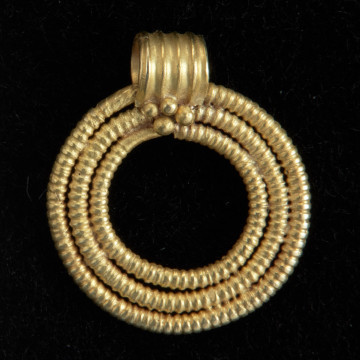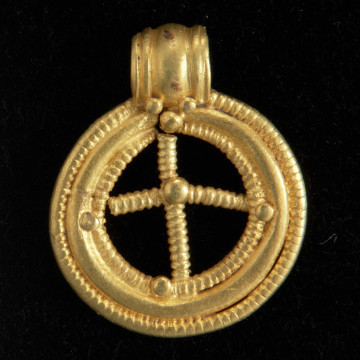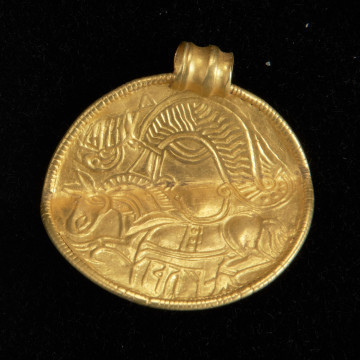
Ring pendant
National Museum in Szczecin
Part of the collection: Antiquity
The gold ring-shaped pendant made of three rings of gold beaded wire has an eyelet of the gold plate with five ribs made in repoussé technique. At the base of the eyelet, there is an ornament of asymmetrically placed gold balls, with six on one side and four on the other. Pendants of this type have been found in southern Scandinavia. Examples include specimens from Ökne in Sweden, Mausing Mark on Jutland, Høvlsbakke on Zealand and Vasegård on Bornholm. In Poland, some analogous specimens were found in the present-day Kujawy. Pendants analogous to the Suchań specimen are also found in Western Europe, for example in Thuringia. These ornaments are generally dated to the period of 450-540, while the youngest specimens, associated with the Merovingian culture, are dated to the 6th-7th century and come from western France, southeastern England, the Netherlands and eastern Germany. The Suchań pendant was part of a hoard of gold objects. The entire assemblage can be dated to the 5th century, the middle Migration Period. Numerous hoards of gold and silver ornaments and coins from similar times have been found in Pomerania. The chronology of many hoards coincides with turbulent events known from written sources, such as the Hun invasion of southern Europe in the 4th century. Even inhabitants of such distant regions as Western Pomerania could be affected by the consequences of such events. Other hoards are considered to be deposits made in relation to religious practices.
Bartłomiej Rogalski
Author / creator
Dimensions
cały obiekt:
Object type
pendicle, pendant
Technique
forming; punching
Material
gold
Creation / finding place
Owner
Muzeum Narodowe w Szczecinie
Identification number
Location / status

National Museum in Szczecin

National Museum in Szczecin

National Museum in Szczecin
DISCOVER this TOPIC
National Museum in Szczecin
DISCOVER this PATH
Educational path